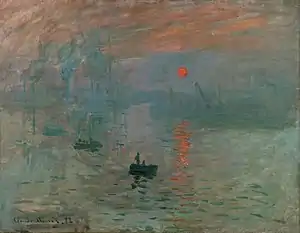Vladimir Kozlovsky | |
|---|---|
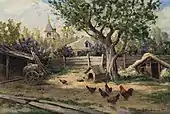 Barnyard birds (1915) | |
| Born | 1867 |
| Died | 1930 |
| Nationality | Russian |
| Education | Moscow School of Painting, Sculpture and Architecture |
| Known for | Painting |
| Notable work | Summer Noon (1894) Zhytomyr Road (1915) |
| Movement | Impressionism |
Vladimir Ivanovich Kozlovsky (Russian: Владимир Иванович Козловский; 1867 - 1930) was an Impressionist painter from the Russian Empire and later the Soviet Union.
Biography
At the age of 13 years, Vladimir Kozlovsky entered the Moscow School of Painting, Sculpture and Architecture, where he studied with Konstantin Korovin and Isaac Levitan.[1] His professional development was heavily influenced by his friends as well as his teachers, Alexei Savrasov, Vasily Polenov and Vasily Perov. After graduation in 1887, Vladimir went back to Kiev and was soon accepted by the Kiev Imperial Society for the Encouragement of the Arts (1890 - 1896). Kozlovsky's early paintings won multiple awards in Kiev and Moscow during these years, including "Quiet Monastery" (1892), "Sweet home" (1893), "Noon" (1894) and "Pine Forest" (1895).[2]
By the beginning of the 20th century, Kozlovsky became one of the Russian impressionists, joining the growing art movement in the country. In his paintings, Vladimir connected the landscape painting traditions of his teacher, Vasily Polenov, with genre scenes of Vasily Perov, vividly describing simple life of Ukrainian peasants. In 1915, Vladimir Kozlovsky was a founding member of the Kiev Society of Artists (1914-1919) and served as Secretary of this society for 5 years.[3] His paintings were exhibited throughout the Russian Empire, including Moscow, Saint Petersburg, Kiev, Odessa, Kharkov, Zhytomyr and other cities.[4] Several of his most famous pieces, such as "Winter", "Printemps", "Road to Zhytomyr", "Pond", "At the river", "Fishermen" were published as postcards.[5]
After the Russian Revolution of 1917, many painters had to leave the country. The new communist ideology was particularly hostile to the "bourgeois" impressionist art movement, deemed to be incompatible with the communist values. Vladimir Kozlovsky remained in Kiev and started working as an illustrator of children's books,[6] cooperating with the same publishing houses that earlier were publishing his paintings. Vladimir Kozlovsky died in 1930, and was buried in the old Baikove Cemetery in Kiev[7]
Works
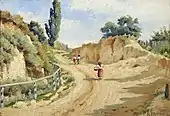 Summer noon. 1894.
Summer noon. 1894.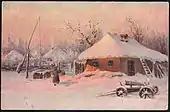 Winter. Postcard.
Winter. Postcard.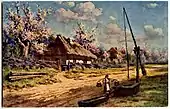 Printemps. Postcard.
Printemps. Postcard.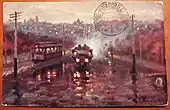 Zhytomyr Road. Postcard. 1912.
Zhytomyr Road. Postcard. 1912. Pond. Postcard.
Pond. Postcard. Barnyard birds. 1915.
Barnyard birds. 1915.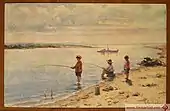 Fishermen. Postcard.
Fishermen. Postcard.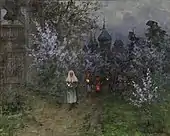 Orthodox Procession
Orthodox Procession Fording the River. 1914
Fording the River. 1914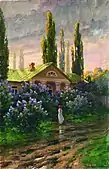 After a Thunderstorm
After a Thunderstorm A Flower Girl
A Flower Girl Illustrations in Children's books. 1930.
Illustrations in Children's books. 1930.
References
- ↑ "Russian State Archive of Literature and Arts". Retrieved 3 November 2019.
- ↑ "Vladimir Ivanovich Kozlovsky. Biography and Artworks". Retrieved 3 November 2019.
- ↑ "Korners Auction House". Retrieved 3 November 2019.
- ↑ Naukove tovarystvo im. Shevchenka., Donetskie viddilennia. (2001). Donetskyi visnyk Naukovoho tovarystva im. Shevchenka (in Russian). Donetsk: Ukraiinskyi kulturolohichnyi tsentr. pp. 507–509.
- ↑ "Postcards by Vladimir Kozlovsky". Retrieved 3 November 2019.
- ↑ "Children's book illustrated by Kozlovsky". Retrieved 3 November 2019.
- ↑ "Ukrainian Wiki, Козловський Володимир Іванович". Retrieved 3 November 2019.
